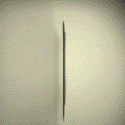One day in the mid-?90s, ace table top director Peter Elliott gathered his three key staffers?assistant director, gaffer and special effects rigger?into his office and told them his plan was to kick back.
To accomplish that, he would build a stable of expert directors, and when they were able to take over, he just would come in and supervise.
“I’ll just come in to keep an eye on you guys,” Michael Azzariti remembers him saying to Tom Lazarivitch, Mark Klein and himself, the rigger.
The plan worked just fine for Klein, who owns his own studio, and for Tom Lazarivitch, whose major client is Perkins Family Restaurants.
But it took Azzariti a decade to get around to directing because he was just too good at his job for Elliot to let loose.
Azzariti is one of the city’s handful of experts who know how to set up the thingamabob and attach it to the whatchamacallit that gives the art director and director precisely the visual effect they seek for a perfect picture.
At the time, Peter Elliott’s studio used American Scene, the rigging company where Azzariti worked, for his specialty rigging needs. One day Elliott’s producer frantically called Azzariti, personally, for help.
“They were literally in the middle of a Coca-Cola shoot and couldn’t get the pour Peter needed from a Coke dispenser?the kind where you push a cup against it and liquid comes out. The liquid came out in a thin stream and ended in a trickle.”
Left to his own devices, Azzariti delivered the perfect pour within an hour. “We created our own mechanical for the machine by putting a pressure container behind the valve. It produced the strong start and crisp finish they needed?and set the tone for my career.”
Elliott hired him on the spot.
As a core member of Elliott’s team, Azzariti was open to the different opportunities that allowed him to collaborate with some of the city’s best riggers and directors, and work on commercials for Fortune 500 companies.
He stayed there a decade until Elliott closed shop in 1998 (Elliott’s building was eventually sold to Harpo Studios) and worked for David Deahl, Klein, Lazarivitch, Dallas-based shooter Tom Ryan and others.

















